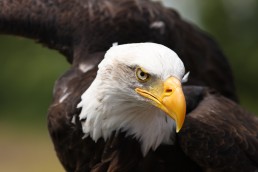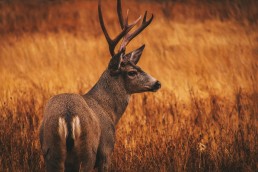Spaulding Outdoors: The Inside on Indiana’s Outside
SHARE THIS POST
Indiana’s oldest known bald eagle spotted again at Monroe Lake
The 28-year-old bald eagle that was one of the original birds brought to Indiana in the 1980s as part of a restoration program has been spotted once again at Monroe Lake.
Bald eagle “C43” is the oldest known bald eagle in Indiana. She arrived in 1988 as a nestling from Whitestone Harbor, Alaska. Biologists brought her and 72 other eaglets to Indiana to start the bald eagle restoration program, which included releasing the young birds at Monroe Lake with the hope they would return to the state to nest. C43 is the number on a leg band identifying the bird for scientists and wildlife watchers.
C43 may still be nesting at Monroe Lake according to Amy Kearns, assistant nongame bird biologist with the DNR Division of Fish and Wildlife.
“This bird may be one of the top 10 oldest wild bald eagles in the United States, with only seven other banded eagles reported living to 28 years or more,” Kearns said.
The latest sighting was on November 4 at Monroe Lake by Clare Bozell. It is the second year in a row Bozell has spotted C43 in the same area at the same time.
C43 was released from the hack tower on September 6, 1988 at Monroe Lake. In January 1989, C43 was sighted in Tennessee at Reelfoot National Wildlife Refuge. From November 1989 to January 1990, C43 was sighted in Kentucky at Ballard County Wildlife Management Area. In March 1994, she was sighted in Indiana at her nest on Monroe Lake. In July 2015, C43 was spotted at Monroe Lake with a brood patch, indicating she may have raised young during the summer.
Bald eagles were on the state and federal endangered species list when Indiana began its reintroduction program in 1985. In 1991, the first successful nesting occurred. In 2016, there were an estimated 250 to 300 eagle-nesting territories in Indiana with 179 bald eagle nests confirmed as active.
This reintroduction program was the first endangered species restoration project initiated by DNR nongame wildlife staff. The project and ongoing research would not be possible without donations to the Indiana Nongame Fund, the main monetary source of all nongame and endangered species research and management.
In 2016, the Nongame Fund took a drastic hit with a 60 percent decline in donations compared to the long-term average. Hoosiers can help by donating a portion of their state tax returns to the fund or by donating online. For every $5 donated to the Nongame Fund, another $9 is awarded through federal grants. Donations can also be made online at endangeredwildlife.IN.gov.
State forest inventory helping keep track of Indiana’s trees
The DNR Division of Forestry has released the state forest inventory analysis for 2015. The report contains data on overall tree diversity, growth and mortality.
“The data indicate that a significant portion of the mature trees in the state forest are aging, succumbing to natural events and a combination of those factors,” said John Seifert, director of the DNR Division of Forestry.
The report notes the tree species dominating today’s forests are not being replaced with adequate numbers of young seedlings of the same species. A part of natural succession, the condition is occurring in both public and private forests across the state.
“Maintaining the current tree species mix will probably take a more intensive management approach than has been done in the past,” Seifert said. “These are generational trends that will take many years to resolve.”
Another noteworthy item from the report is tree mortality occurring in the state. The data indicates about 10.8 million board feet are lost annually, with 1.7 million standing dead trees measuring more than 5 inches in diameter. Some of the tree mortality is linked to recent drought starting to take a toll within one to five years following the actual drought event.
Periodic insect outbreaks are also analyzed in the report, particularly the 2012-2013 occurrence of tulip poplar scale. Also noteworthy is the declining state of the many pine stands planted in years past in order to heal abused, eroded, old pasture and crop fields.
“What was not expected was the revelation that 49 percent of those dead trees are oaks, species that usually withstand drought and insect events,” Seifert said.
The entire report can be viewed at dnr.IN.gov/forestry/3605.htm.
Other noteworthy findings and data:
- 156,185 total acres and 150,932 forested acres with the balance in non-forest (i.e., campgrounds) and water
- 96 percent of the forested acres are hardwoods
- 85 percent of the forested acres are saw log-sized stands
- Forests contain 58.6 million live trees
- Sugar maple trees and seedlings are more abundant than any other species
- 337.1 million cubic feet of total live tree volume
- 1.159 billion board feet (Doyle) of saw log volume
- White oaks followed by red oaks are the species groups with the most saw log volume
- More than half of the saw log volume is considered “Grade 1 or 2”
- Japanese honeysuckle, multiflora rose and stiltgrass are the most common invasive species
Michael Jordan at the Birdfeeder
Are you enjoying this post?
You can be among the first to get the latest info on where to go, what to use and how to use it!
When I first installed my sunflower seed birdfeeder I hung it from a single cable attached to a high limb and positioned the wire basket 42 inches above the ground. At that height, I knew it was safe from all ground attacks by chipmunks and squirrels; they simply could not reach the feeder by jumping. The four-legged critters were welcome to clean up under the feeder, but no direct access was allowed. Then during a heavy snowfall last year, a drift formed under the feeder and temporarily allowed a squirrel to access it. Following a brief warm-up that put an end to the snow on the ground, there was no more access, as it was once again too high to reach for the animals.
Christmas weekend I glanced out the window. And, to my amazement, there was a squirrel hanging upside down on the feeder with its back legs tucked in the top bail as it hard at work shoveling the seeds with its front paws into its mouth. Yanking open the window, I then gave my best attempt at barking like a dog. The squirrel quickly bailed off the feeder while my wife looked around the corner.
“What’s wrong with you?” she asked.
Explaining my immediate need to vacate the larcenous squirrel, all I could think of was to try to sound like a mean dog. She said I sounded more like a crazed banshee.
I couldn’t believe that this squirrel got to the feeder, so I watched for its return. Unfortunately, my barking was highly effective and the squirrel didn’t come back again for another run.
The next day I checked, and sure enough, that squirrel was back. Not wishing to scare it out of the county, I eased the window open and barked softly, kind of like a sick Chihuahua.
The squirrel quickly looked up and jumped off the feeder, but didn’t run away.I watched carefully, fully expecting it to climb up a nearby tree and jump onto the feeder.
Then, I got the surprise of my life. The little rascal simply coiled its back legs and shot straight up in the air. At the very height of the jump, it grabbed the feeder rim with both paws like Michael Jordan grabbing the rim while dunking a basketball and it pulled itself up onto the wire basket. Quickly, it whipped its back legs over its head and hooked them in the bail and hung upside down, free to use its front paws to start shoveling seeds.
The NBA, for my league in my backyard, must stand for the “Nut Baggers Association.”
Loading up the birdfeed bucket with some more sunflower seeds and a new suet cake, I then headed out to replenish the feeder. I also brought along my measuring tape.
Sure enough, the bottom of the feeder was a good 42 inches off the ground. I adjusted the cable and checked the new level now at 48 inches.
We’ll see how successful you are now, “Squirrel Jordan.” Bring it on!
11,000 Acres Protected In Honor Of State’s Bicentennial
The DNR and the Bicentennial Commission announced recently more than 11,000 acres have been protected through the efforts of the Bicentennial Nature Trust (BNT).
The BNT was launched in 2012 as a project of the Bicentennial Commission. The program works to acquire land for conservation and recreation to serve as a perpetual gift to all Hoosiers in celebration of Indiana’s 200 years of statehood. The statewide effort honors the establishment of the state park system created in 1916 to commemorate Indiana’s centennial.
The BNT has completed 129 land acquisition projects to date for a total of 11,096 acres statewide. The projects enhance public access to recreational trails, public hunting and fishing opportunities, wildlife observation and conservation of fragile natural habitats. Partners include local park systems, land trusts, trails groups, and land-holding divisions of the DNR. More than 70 percent of BNT funds have been awarded to non-state partners.
Indiana obligated $20 million for BNT projects, while the Lilly Endowment donated another $10 million. The program requires money from the fund and is matched with no less than $1.1 million by project sponsors. To date, projects sponsors have matched $1.41 for every BNT dollar.
For more information on the Bicentennial Commission visit indiana2016.org. A list of approved projects and an interactive map can be found at in.gov/dnr/7577.htm.
Jack Spaulding may be contacted at jackspaulding@hughes.net.
MWO
SHARE THIS POST
Did you enjoy this post?
You can be among the first to get the latest info on where to go, what to use and how to use it!
Jack Spaulding
Jack Spaulding is an outdoor columnist living in his hometown of Moscow, Ind. with his wife, Chris. From childhood, the smallmouth bass-infested Big Flat Rock River and the surrounding hardwood forest has been his playground. He has written Spaulding Outdoors for MidWest Outdoors since 1986. Email to jackspaulding@hughes.net.



